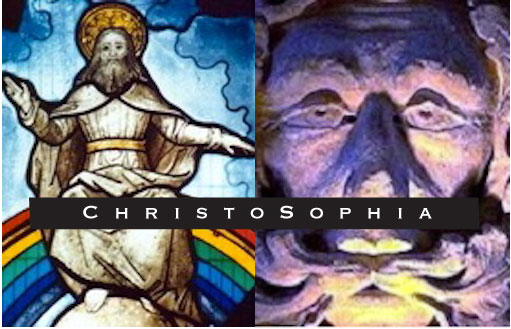
.
ChristoSophia in Cornwall
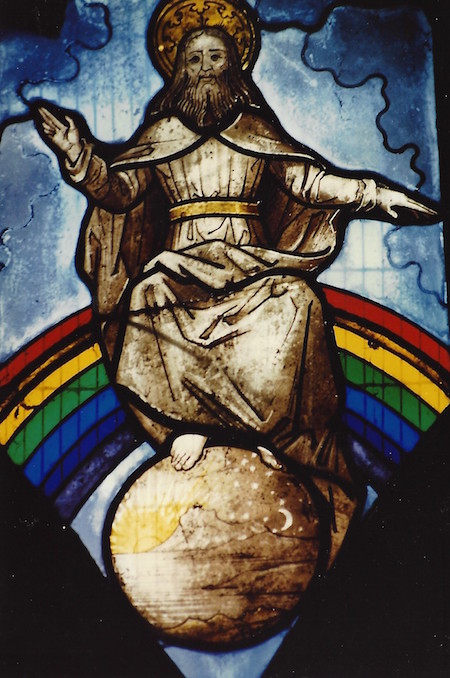
On a gray morning in May of 1995, we drove through the misty countryside of Cornwall, England, on our way to the little town of St. Neot. This picturesque Cornish village, which had quite a cozy feeling despite the cold drizzle of rain, contained a holy well and church that we wanted to visit as we made our pilgrimage to sacred sites. The village is named after St. Neot, apparently a mysterious character about whom no true facts seem to be known. He was perhaps a Saxon or a Celtic saint, but in any case this area does seem to have been a center for the Celtic Christian church.
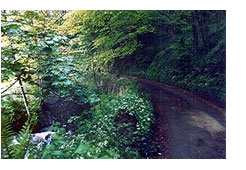 After arriving in the village, we first walked down a small country lane, with a swiftly flowing stream on our left and a high bank of wildflowers on our right. The mist arising from the lightly falling rain seemed to simply add to the atmosphere of magic and mystery that is such a strong feature of the Cornish countryside. The beauty of this little lane in its sylvan setting made us feel very close to those Celtic Christians who had worshipped God through their love of the natural world. The lane opened up into a field, where we found St. Neot's holy well in a little stone well house set back against a bank of trees. As we collected some of the holy water, a blackbird flew down to the cross on top of the well house and sang for us – truly, we felt, a blessing from Sophia!
It also turned out to be an augury for the next step on our pilgrimage, for we walked back down the lane to St. Neot's Church,
After arriving in the village, we first walked down a small country lane, with a swiftly flowing stream on our left and a high bank of wildflowers on our right. The mist arising from the lightly falling rain seemed to simply add to the atmosphere of magic and mystery that is such a strong feature of the Cornish countryside. The beauty of this little lane in its sylvan setting made us feel very close to those Celtic Christians who had worshipped God through their love of the natural world. The lane opened up into a field, where we found St. Neot's holy well in a little stone well house set back against a bank of trees. As we collected some of the holy water, a blackbird flew down to the cross on top of the well house and sang for us – truly, we felt, a blessing from Sophia!
It also turned out to be an augury for the next step on our pilgrimage, for we walked back down the lane to St. Neot's Church, 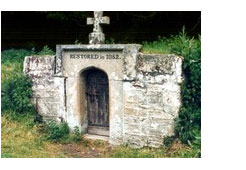 which we found to be a delightful surprise. As we entered the churchyard we immediately encountered four wonderful, old granite crosses, one dating from the 10th century that is thought to be perhaps the finest of all Cornish crosses. But the greatest blessing remained until we entered the church itself, where we were captivated by the beauty of all of the stained glass windows. Then we saw one in particular, called the "Noah window," and were awestruck by its incredible ChristoSophia imagery. In this window the deity (either God or Christ) sits with his feet resting on a disc and a rainbow spans the heavens behind him. The disc would seem to represent the Earth, particularly since it contains an image of cliffs rising from the water, like the coast
which we found to be a delightful surprise. As we entered the churchyard we immediately encountered four wonderful, old granite crosses, one dating from the 10th century that is thought to be perhaps the finest of all Cornish crosses. But the greatest blessing remained until we entered the church itself, where we were captivated by the beauty of all of the stained glass windows. Then we saw one in particular, called the "Noah window," and were awestruck by its incredible ChristoSophia imagery. In this window the deity (either God or Christ) sits with his feet resting on a disc and a rainbow spans the heavens behind him. The disc would seem to represent the Earth, particularly since it contains an image of cliffs rising from the water, like the coast
of Cornwall.
The message here seems to be that it is the Lord that reigns as sovereign and protector of this land. But the symbolic meaning is also deeper than this, for the Sun and Moon also appear within the disc. This implies that the Lord reigns not only over the Earth, but over the entire cosmos. Within creation are both the Sun and the Moon, representing the masculine and the feminine archetypal energies. These polarities are integrated in the divine image of ChristoSophia, that unites the created and the transcendent worlds. The rainbow also symbolizes the reconciliation of Earth and Heaven. As the name of the window itself recalls, the rainbow in Christian tradition is primarily associated with the story of Noah. After the flood, God said the rainbow is to be
“the sign of the covenant which I make between me and you and every living creature that is with you.”As the Russian Sophiologist Vladimir Solovyev explains, the rainbow is a visual image that reminds us that “Heaven stoops toward Earth; the world is not only a world in itself, it is also a world in God, and God abides not only in heaven but also on Earth.”(1) The beautiful multi-colors of the rainbow symbolize the glorious diversity which is found as God manifests in creation. In both the images of the rainbow and the Deity spanning Heaven and Earth, we see ChristoSophia in the stained glass
(Gen. 9:12)
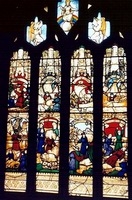 window at St. Neot's. Here the transcendent and the creaturely dimension are united within ChristoSophia, creating a divine synthesis which symbolizes the restoration of unity between God and creation.
window at St. Neot's. Here the transcendent and the creaturely dimension are united within ChristoSophia, creating a divine synthesis which symbolizes the restoration of unity between God and creation. It occurred to us that this representation of ChristoSophia was especially appropriate in St. Neot's, an important site of Celtic Christianity, for it was the Celtic Christians who understood the truth of God's presence in creation and celebrated the sacredness of the natural world. This spiritual insight of the Celtic Christians was also expressed in the “Celtic Benediction” that we happened to see on the church bulletin board as we walked to the door to take our leave:
The peace of the running wave to you,
The peace of the flowing air to you,
The peace of the quiet earth to you,
The peace of the shining stars to you,
And the peace of the Son of Peace to you
This benediction was truly a final blessing for us as we departed from St. Neot's.
1. Sergei Bulgakov, Sophia: The Wisdom of God (NY: Lindisfarnbe Press, 1993), p. 17
Back to top
In both the images of the rainbow and the Deity spanning Heaven and Earth, we see ChristoSophia in the stained glass window at St. Neot’s. Here the transcendent and creaturely dimension are united in ChristoSophia, creating a divine synthesis which symbolizes the restoration of unity between God and creation.
The rainbow is a visual image that reminds us that “Heaven stoops toward Earth… God abides not only in heaven but also on Earth.”
It was the Celtic Christians who understood the truth of God’s presence in creation and celebrated the sacredness of the natural world.